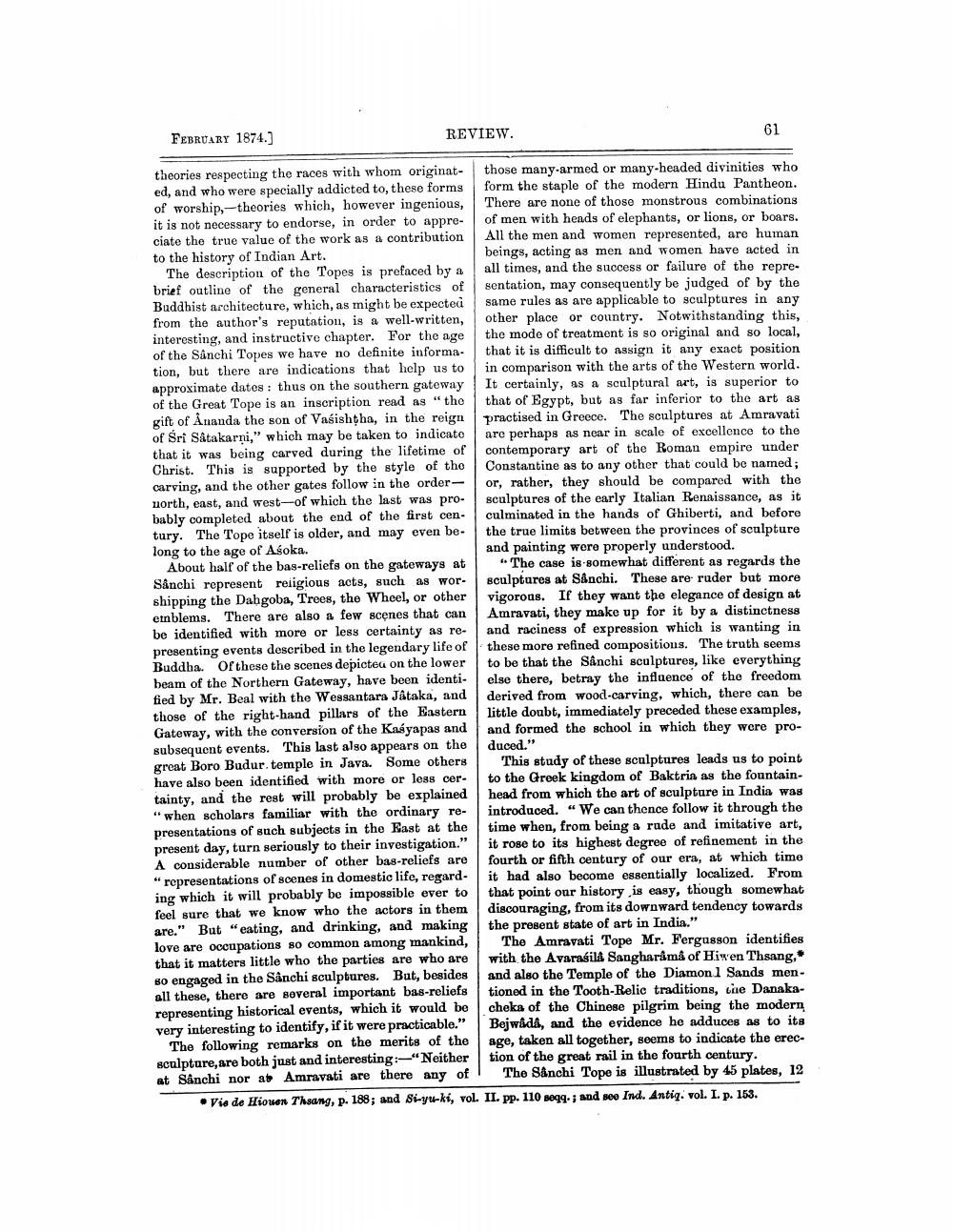________________
FEBRUARY 1874.]
REVIEW.
theories respecting the races with whom originated, and who were specially addicted to, these forms of worship,-theories which, however ingenious, it is not necessary to endorse, in order to appreciate the true value of the work as a contribution to the history of Indian Art.
The description of the Topes is prefaced by a brief outline of the general characteristics of Buddhist architecture, which, as might be expected from the author's reputation, is a well-written, interesting, and instructive chapter. For the age of the Sânchi Topes we have no definite information, but there are indications that help us to approximate dates: thus on the southern gateway of the Great Tope is an inscription read as "the gift of Ananda the son of Vasishtha, in the reign of Sri Satakarni," which may be taken to indicate that it was being carved during the lifetime of Christ. This is supported by the style of the carving, and the other gates follow in the ordernorth, east, and west-of which the last was probably completed about the end of the first century. The Tope itself is older, and may even belong to the age of Aśoka.
About half of the bas-reliefs on the gateways at Sânchi represent reiigious acts, such as worshipping the Dabgoba, Trees, the Wheel, or other emblems. There are also a few scenes that can be identified with more or less certainty as representing events described in the legendary life of Buddha. Of these the scenes depicted on the lower beam of the Northern Gateway, have been identified by Mr. Beal with the Wessantara Jâtaka, and those of the right-hand pillars of the Eastern Gateway, with the conversion of the Kasyapas and subsequent events. This last also appears on the great Boro Budur. temple in Java. Some others have also been identified with more or less certainty, and the rest will probably be explained "when scholars familiar with the ordinary representations of such subjects in the East at the present day, turn seriously to their investigation." A considerable number of other bas-reliefs are "representations of scenes in domestic life, regarding which it will probably be impossible ever to feel sure that we know who the actors in them are." But "eating, and drinking, and making love are occupations so common among mankind, that it matters little who the parties are who are so engaged in the Sânchi sculptures. But, besides all these, there are several important bas-reliefs representing historical events, which it would be very interesting to identify, if it were practicable."
61
The following remarks on the merits of the sculpture, are both just and interesting:-"Neither at Sânchi nor at Amravati are there any of
those many-armed or many-headed divinities who form the staple of the modern Hindu Pantheon. There are none of those monstrous combinations of men with heads of elephants, or lions, or boars. All the men and women represented, are human beings, acting as men and women have acted in all times, and the success or failure of the representation, may consequently be judged of by the same rules as are applicable to sculptures in any other place or country. Notwithstanding this, the mode of treatment is so original and so local, that it is difficult to assign it any exact position in comparison with the arts of the Western world. It certainly, as a sculptural art, is superior to that of Egypt, but as far inferior to the art as practised in Greece. The sculptures at Amravati are perhaps as near in scale of excellence to the contemporary art of the Roman empire under Constantine as to any other that could be named; or, rather, they should be compared with the sculptures of the early Italian Renaissance, as it culminated in the hands of Ghiberti, and before the true limits between the provinces of sculpture and painting were properly understood.
"The case is somewhat different as regards the sculptures at Sânchi. These are ruder but more vigorous. If they want the elegance of design at Amravati, they make up for it by a distinctness and raciness of expression which is wanting in these more refined compositions. The truth seems to be that the Sânchi sculptures, like everything else there, betray the influence of the freedom derived from wood-carving, which, there can be little doubt, immediately preceded these examples, and formed the school in which they were produced."
This study of these sculptures leads us to point to the Greek kingdom of Baktria as the fountainhead from which the art of sculpture in India was introduced. "We can thence follow it through the time when, from being a rude and imitative art, it rose to its highest degree of refinement in the fourth or fifth century of our era, at which time it had also become essentially localized. From that point our history is easy, though somewhat discouraging, from its downward tendency towards the present state of art in India."
The Amravati Tope Mr. Fergusson identifies with the Avarasila Sangharâmå of Hiwen Thsang,* and also the Temple of the Diamon 1 Sands mentioned in the Tooth-Relic traditions, the Danakacheka of the Chinese pilgrim being the modern Bejwâdâ, and the evidence he adduces as to its age, taken all together, seems to indicate the erection of the great rail in the fourth century.
The Sânchi Tope is illustrated by 45 plates, 12
Vie de Hiouen Thsang, p. 188; and Si-yu-ki, vol. II. pp. 110 seqq.; and see Ind. Antiq. vol. I. p. 153.




